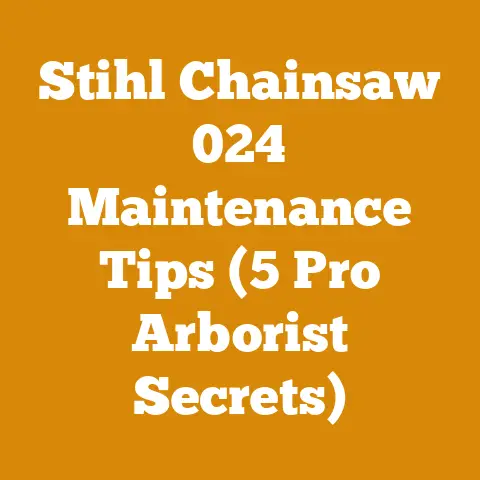How Much Are Morel Mushrooms Worth? (Woodland Foraging Secrets)
Imagine stumbling through a sun-dappled forest, the earthy scent of decaying leaves filling your nostrils. You’re on the hunt, not for game, but for something far more elusive and, pound for pound, potentially more valuable: morel mushrooms. But what are they really worth? Is it just a fun hobby, or could it supplement your income, maybe even fund that new chainsaw you’ve been eyeing? That’s what I’m going to explore in depth, drawing from my own experiences in the woods and my knowledge of the market.
The Allure of the Morel: More Than Just a Mushroom
Morel mushrooms, with their honeycomb caps and earthy flavor, are a culinary delicacy. But their value extends beyond the kitchen. They represent a connection to nature, a challenge to the forager, and, yes, a potential source of income. Understanding their worth requires digging into several layers, from the biology of the mushroom itself to the fluctuating market dynamics that dictate their price.
What Makes Morels So Special?
- Rarity: Morels are notoriously difficult to cultivate commercially. They primarily grow in the wild, making them a seasonal and unpredictable treat.
- Flavor: Their unique, earthy, nutty flavor profile is highly sought after by chefs and food enthusiasts.
- Mystique: The hunt for morels is a tradition, often passed down through generations. There’s a certain thrill in finding these hidden treasures.
Unveiling the Price Tag: How Much Are Morels Worth?
The price of morel mushrooms fluctuates wildly depending on several factors. Let’s break down the key determinants:
Fresh vs. Dried Morels: A Tale of Two Markets
The form in which you sell morels significantly impacts their value.
- Fresh Morels: These command the highest prices, typically ranging from $20 to $40 per pound when sold directly to consumers at farmers’ markets or roadside stands. Prices can surge to $60+ per pound when sold to restaurants or specialty food stores, especially early in the season.
- Dried Morels: Drying concentrates the flavor and extends the shelf life, but it also reduces the weight. Dried morels typically sell for $80 to $200 per pound, depending on quality and origin.
Seasonality and Location: Timing is Everything
Morel season is relatively short, typically lasting from April to June in most parts of North America. The earlier in the season and the further north you go, the higher the prices tend to be.
- Early Season Premium: The first morels to appear in a region often fetch the highest prices due to pent-up demand. I remember one year, finding a patch in early April after a particularly warm spell. I sold them for $75 a pound at a local farmer’s market.
- Geographic Variations: Prices also vary by region. Areas with a strong culinary scene and a tradition of foraging (like the Pacific Northwest or parts of the Midwest) tend to have higher prices.
Quality and Quantity: The Golden Rules of Commerce
The quality and quantity of your morel harvest also play a crucial role in determining their worth.
- Size and Condition: Larger, intact morels with minimal blemishes command higher prices. Bruised or damaged morels will fetch significantly less.
- Bulk Discounts: Selling in larger quantities can sometimes lower the price per pound, but it can also open up opportunities to sell to wholesalers or restaurants.
Understanding Market Dynamics: Where to Sell Your Morels
Knowing where to sell your morels is just as important as finding them. Here are a few options:
- Direct to Consumers: Farmers’ markets, roadside stands, and online platforms like Etsy can be great options for selling directly to consumers. This allows you to capture the highest prices but requires more effort in terms of marketing and customer service.
- Restaurants and Specialty Food Stores: Local restaurants and specialty food stores are often willing to pay a premium for fresh, high-quality morels. Building relationships with chefs and buyers can be a lucrative strategy.
- Wholesalers and Distributors: Selling to wholesalers or distributors is the easiest way to move large quantities of morels, but it also results in the lowest prices. This is a good option if you have a large harvest and want to avoid the hassle of direct sales.
The Morel Hunter’s Toolkit: Beyond the Basket
While finding morels is an art, preparing them for sale requires some practical tools and techniques.
Cleaning and Preparation: First Impressions Matter
Proper cleaning and preparation are essential for maximizing the value of your morels.
- Gentle Cleaning: Gently brush off any dirt or debris with a soft brush. Avoid washing them unless absolutely necessary, as this can make them soggy.
- Sorting and Grading: Sort your morels by size and quality. Separate out any damaged or bruised specimens.
- Proper Storage: Store fresh morels in a breathable container (like a paper bag) in the refrigerator. Avoid storing them in plastic bags, as this can cause them to become slimy.
Drying Morels: Preserving the Treasure
Drying morels is a great way to extend their shelf life and increase their value.
- Slicing: Slice the morels lengthwise into even pieces. This will help them dry more evenly.
- Drying Methods:
- Food Dehydrator: This is the most efficient and reliable method. Follow the manufacturer’s instructions for drying mushrooms.
- Oven Drying: Set your oven to the lowest possible temperature (ideally below 170°F) and dry the morels on a baking sheet lined with parchment paper. This method requires constant monitoring to prevent burning.
- Air Drying: This is the most traditional method. String the morel slices onto a thread and hang them in a well-ventilated area. This method can take several days or even weeks, depending on the humidity.
- Proper Storage: Store dried morels in an airtight container in a cool, dark place.
Beyond the Mushroom: Integrating Foraging with Wood Processing
Now, let’s connect this to my world of wood processing and firewood preparation. Foraging for morels can be seamlessly integrated into your woodland management activities.
Sustainable Harvesting: Protecting the Resource
Sustainable harvesting practices are crucial for ensuring the long-term availability of morels.
- Leave Some Behind: Always leave some morels behind to allow them to reproduce.
- Avoid Over-Harvesting: Don’t strip an area bare. Take only what you need or what you can reasonably sell.
- Respect the Environment: Avoid disturbing the soil or damaging other plants.
Habitat Management: Creating Morel-Friendly Forests
Certain woodland management practices can actually enhance morel production.
- Thinning: Thinning out dense stands of trees can allow more sunlight to reach the forest floor, which can stimulate morel growth. This is where my chainsaw skills come in handy. Careful and selective thinning can create ideal conditions.
- Controlled Burns: In some areas, controlled burns can also promote morel growth. However, this is a complex and potentially dangerous practice that should only be undertaken by experienced professionals.
- Ash Placement: I’ve noticed morels often pop up around areas where I’ve burned brush piles from clearing land for firewood. The ash seems to provide a beneficial nutrient boost.
From Forest to Firewood: A Symbiotic Relationship
The process of harvesting firewood can actually complement morel foraging.
- Timing: Morel season often coincides with the time when you’re preparing your woodlot for the upcoming winter. You can combine these activities to maximize your time in the woods.
- Observation: While cutting and splitting firewood, keep an eye out for potential morel habitats. Disturbed soil, dying trees, and areas with ash are all good places to look.
- Waste Utilization: The wood chips and sawdust generated from firewood processing can be used to create mushroom beds. While morels are notoriously difficult to cultivate, other edible mushrooms like oyster mushrooms can thrive in these environments.
Case Study: My Morel-Fueled Chainsaw Upgrade
Let me share a personal story. A few years ago, my trusty but aging chainsaw finally gave up the ghost. I needed a replacement, and a good one – something with more power for tackling larger logs. But chainsaws aren’t cheap.
That spring, I had a particularly bountiful morel season. I spent weekends combing through my woodlot, carefully harvesting the precious fungi. I sold them at the local farmer’s market, building a loyal customer base who appreciated the quality and freshness of my finds.
By the end of the season, I had earned enough money to not only buy a new, top-of-the-line chainsaw but also invest in some essential safety gear. That chainsaw has since helped me process countless cords of firewood, providing heat for my home and income from sales. It’s a testament to the potential of combining woodland foraging with wood processing.
The Legal and Ethical Considerations: Foraging Responsibly
Before you head out into the woods, it’s essential to understand the legal and ethical considerations surrounding morel foraging.
Permission and Permits: Respecting Property Rights
- Private Land: Always obtain permission from the landowner before foraging on private property.
- Public Land: Check the regulations for foraging on public lands. Some areas may require permits or have restrictions on the quantity of mushrooms you can collect.
Identification: Safety First
- Positive Identification: Be absolutely certain that you have correctly identified a morel mushroom before consuming it. There are poisonous look-alikes that can cause serious illness or even death. When in doubt, consult with an expert.
- False Morels: Learn to identify false morels, which can be toxic. They typically have a brain-like or saddle-shaped cap that is attached to the stem at the top, unlike true morels, which have a honeycomb-like cap that is attached to the stem along its entire length.
Sustainability: Protecting the Resource
- Responsible Harvesting: Follow sustainable harvesting practices to ensure the long-term availability of morels.
- Avoid Contamination: Do not harvest morels from areas that may be contaminated with pesticides or other pollutants.
Data-Driven Insights: The Economics of Morel Foraging
To truly understand the value of morels, let’s delve into some data-driven insights.
Market Trends: A Volatile Landscape
The price of morels is influenced by a variety of factors, including weather patterns, economic conditions, and consumer demand.
- Weather: Warm, wet springs are generally favorable for morel growth. Drought conditions can significantly reduce yields and drive up prices.
- Economic Conditions: During economic downturns, demand for luxury items like morels may decline, leading to lower prices.
- Consumer Demand: Growing interest in foraging and gourmet cuisine has fueled demand for morels in recent years.
Cost-Benefit Analysis: Is Morel Foraging Worth Your Time?
To determine whether morel foraging is a worthwhile endeavor, it’s essential to consider the costs and benefits involved.
- Costs:
- Time: Morel foraging can be time-consuming, especially if you’re not familiar with the area.
- Travel: You may need to travel to remote locations to find morels.
- Equipment: You’ll need basic equipment like a basket, knife, and field guide.
- Permits: Some areas may require permits for foraging.
- Benefits:
- Income: Selling morels can provide a supplemental income.
- Recreation: Morel foraging can be a fun and rewarding outdoor activity.
- Culinary Delights: You can enjoy the delicious flavor of fresh morels.
Industry Statistics: A Glimpse into the Morel Market
While precise data on the morel market is difficult to obtain, here are some general statistics:
- Annual Production: The annual production of wild morels in North America is estimated to be in the tens of thousands of pounds.
- Market Value: The total market value of morels is estimated to be in the millions of dollars.
- Growing Demand: Demand for morels is growing, driven by increasing interest in foraging and gourmet cuisine.
The Future of Morel Foraging: Challenges and Opportunities
The future of morel foraging is uncertain, but there are both challenges and opportunities on the horizon.
Climate Change: A Threat to Morel Habitats
Climate change is a significant threat to morel habitats. Changes in temperature and precipitation patterns can disrupt the delicate ecological balance that morels depend on.
Habitat Loss: The Impact of Development
Habitat loss due to development and deforestation is also a major concern. As forests are cleared for agriculture and urbanization, morel habitats are destroyed.
Cultivation Efforts: The Quest for Domestication
Researchers are working to develop methods for cultivating morels commercially. While progress has been made, widespread commercial cultivation remains a challenge.
Sustainable Practices: Protecting the Future
Sustainable harvesting practices are essential for ensuring the long-term availability of morels. By following ethical guidelines and respecting the environment, we can help protect this valuable resource for future generations.
Practical Tips and Actionable Advice: Your Morel Foraging Guide
Here are some practical tips and actionable advice to help you succeed in your morel foraging endeavors:
- Do Your Research: Learn about the habitat preferences of morels in your area.
- Scout Early: Start scouting for morels early in the season.
- Look in Disturbed Areas: Morels often grow in disturbed areas, such as recently burned forests, logging sites, and orchards.
- Check Around Trees: Look for morels around the base of trees, especially ash, elm, and apple trees.
- Be Patient: Morel foraging requires patience and persistence. Don’t give up if you don’t find them right away.
- Join a Foraging Group: Connect with other foragers in your area to share tips and information.
- Attend a Foraging Workshop: Attend a foraging workshop to learn from experts and gain hands-on experience.
- Invest in a Good Field Guide: A good field guide will help you identify morels and other edible mushrooms.
- Practice Safe Foraging: Always be certain of your identification before consuming any wild mushroom.
Conclusion: The Morel’s Worth – A Multifaceted Gem
So, how much are morel mushrooms worth? The answer is multifaceted. Financially, they can be a valuable source of income, supplementing your earnings and even funding larger purchases like that dream chainsaw. But their worth extends far beyond monetary value. They represent a connection to nature, a challenge to the forager, and a culinary delicacy.
By understanding the market dynamics, practicing sustainable harvesting techniques, and integrating foraging with woodland management activities, you can unlock the full potential of this woodland treasure. And who knows, maybe next season, you’ll be the one funding your next big project with the fruits (or rather, fungi) of your labor.






